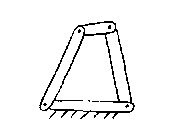piano mechanism stage
A four bar linkage will be used. Four rigid body links joined by lossless pin joints- ignore all friction and flexural effects. Use rigid body motion but do include gravity

 This four bar linkage can be used to approximately model the wippen, Jack and Hammer.
This four bar linkage can be used to approximately model the wippen, Jack and Hammer.
I.e. The pianist presses the key causing a moment about the pivot. Assume this is just a constant Torque been applied to the wippen. This causes it to rotate and push the jack upwards. The jack pushes on the hammer (assume pin joint contact for simplicity and ignore the string contact) and the whole system continues in this manner (As a four bar linkage with applied external force), until at a specified angle the wippen and jack stop rotating due to making contact with the small piece of wood and the hammer disengages. It can be assumed that the motion of the four bar linkage stops instantly when this point is reached however the current angular velocity and acceleration of the hammer must be recorded for use in part 2. So for part one just plot the position of the four bar linkage with time (or of the components using another method) until the point of disengagement.
This is a single degree of freedom system in θ. i.e. the angles and angular velocities ect of any given link can be expressed in terms of one known angle for any other link.
Hammer is now assumed to be rotating freely with initial angular velocity and acceleration equal to what they where at the end of stage 1 plot its position with time.
However the hammer will eventually reach a specified angle at which point it strikes the string and rebounds with an opposite velocity and acceleration i.e. θ’=-kθ’ θ’’=-kθ’’ where k is coefficient of restitution. Simply use this approximation do not include compressibility friction ect also assume the hammer rebounds instantaneously.
I believe this is similar to modeling a bouncing ball?
Assume that during this stage the pianist’s finger remains on the key hence the wippen and jack remain in place to ‘catch’ the hammer
Ok now there is a simple way or a complicated way
Simple way
Assume hammer is caught and the system once again becomes a four bar linkage. The torque on the wippen is now gone and the system rotates under gravity to its initial position. Plot this with time.
Complicated way
Assume that at some point during stage 2 the pianist releases the key and the wippen and jack now begin to rotate due to gravity. Now the hammer may still be moving in the opposite direction it depends when the pianist removes their finger but essentially at some point the string will become taught and pull the hammer back down. This could be looked at if not solved?? The string can be assumed to be a massless rigid link when taught and have no effect when loose, it can also be assumed that it becomes taught instantaneously at some given angle or separation between the hammer and wippen. This means that when the string becomes taught it becomes a massless extension on the hammer. This means the system can once again be approximated to a set of linked rigid bodies whereby the hammer is now attached to the wippen by the fixed rigid link that is the string.
Assignment Help | Physics Assignment Help | Physics Homework Help | Online Tutoring
